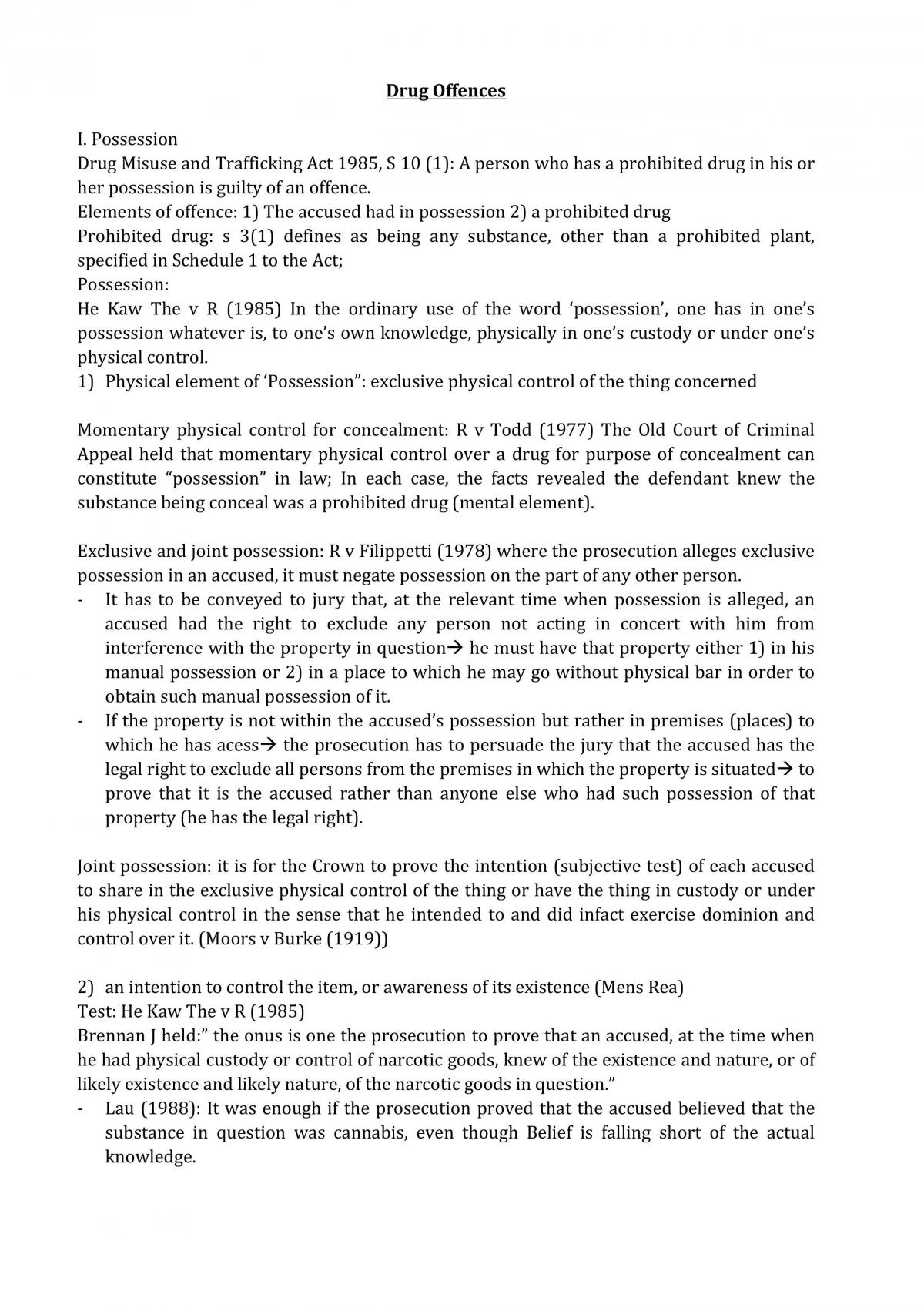Find
Search for over 200,000 study notes and past assignments!
Swap
Download study resources by swapping your own or buying Exchange Credits.
Study
Study from your library anywhere, anytime.
1 Found helpful • 23 Pages • Complete Study Notes • Year: Pre-2021
This is a summary notes for criminal 1, It covers all relevant offenses, tests and relevant cases. For example: I. Possession Drug Misuse and Trafficking Act 1985, S 10 (1): A person who has a prohibited drug in his or her possession is guilty of an offence. Elements of offence: 1) The accused had in possession 2) a prohibited drug Prohibited drug: s 3(1) defines as being any substance, other than a prohibited plant, specified in Schedule 1 to the Act; Possession: He Kaw The v R (1985) In the ordinary use of the word ‘possession’, one has in one’s possession whatever is, to one’s own knowledge, physically in one’s custody or under one’s physical control. 1) Physical element of ‘Possession”: exclusive physical control of the thing concerned Momentary physical control for concealment: R v Todd (1977) The Old Court of Criminal Appeal held that momentary physical control over a drug for purpose of concealment can constitute “possession” in law; In each case, the facts revealed the defendant knew the substance being conceal was a prohibited drug (mental element). Exclusive and joint possession: R v Filippetti (1978) where the prosecution alleges exclusive possession in an accused, it must negate possession on the part of any other person. -‐ It has to be conveyed to jury that, at the relevant time when possession is alleged, an accused had the right to exclude any person not acting in concert with him from interference with the property in questionàhe must have that property either 1) in his manual possession or 2) in a place to which he may go without physical bar in order to obtain such manual possession of it. -‐ If the property is not within the accused’s possession but rather in premises (places) to which he has acessàthe prosecution has to persuade the jury that the accused has the legal right to exclude all persons from the premises in which the property is situatedàto prove that it is the accused rather than anyone else who had such possession of that property (he has the legal right). Joint possession: it is for the Crown to prove the intention (subjective test) of each accused to share in the exclusive physical control of the thing or have the thing in custody or under his physical control in the sense that he intended to and did infact exercise dominion and control over it. (Moors v Burke (1919)) 2) an intention to control the item, or awareness of its existence (Mens Rea) Test: He Kaw The v R (1985) Brennan J held:” the onus is one the prosecution to prove that an accused, at the time when he had physical custody or control of narcotic goods, knew of the existence and nature, or of likely existence and likely nature, of the narcotic goods in question.” -‐ Lau (1988): It was enough if the prosecution proved that the accused believed that the substance in question was cannabis, even though Belief is falling short of the actual knowledge. 3) Minute quantity of substance There is a minimum quantity of drugs that must be found in the possession of the accussed to amount to an offence. Test: Williams (1978) “It (Act) contemplates possession, not of a minute quantity incapable of discernment by naked eye and detectable only by specific meansàbut a possession of such a quantity as makes it reasonable to say as a matter of common sense and reality that it is the prohibited plant or drug of which the person is presently in possession.” Defence: P864 of book Above is the very first part of my notes.
This document is 25 Exchange Credits
More about this document:
|
|
This document has been hand checkedEvery document on Thinkswap has been carefully hand checked to make sure it's correctly described and categorised. No more browsing through piles of irrelevant study resources. |
|
|
This is a Complete Set of Study NotesComplete Study Notes typically cover at least half a semester’s content or several topics in greater depth. They are typically greater than 20 pages in length and go into more detail when covering topics. |
|
|
What are Exchange Credits?Exchange Credits represent the worth of each document on Thinkswap. In exchange for uploading documents you will receive Exchange Credits. These credits can then be used to download other documents for free. |
|
|
Satisfaction GuaranteeWe want you to be satisfied with your learning, that’s why all documents on Thinkswap are covered by our Satisfaction Guarantee. If a document is not of an acceptable quality or the document was incorrectly described or categorised, we will provide a full refund of Exchange Credits so that you can get another document. For more information please read Thinkswap's Satisfaction Guarantee. |

Studying with Academic Integrity
Studying from past student work is an amazing way to learn and research, however you must always act with academic integrity.
This document is the prior work of another student. Thinkswap has partnered with Turnitin to ensure students cannot copy directly from our resources. Understand how to responsibly use this work by visiting ‘Using Thinkswap resources correctly’.
Browse UNSW Subjects




